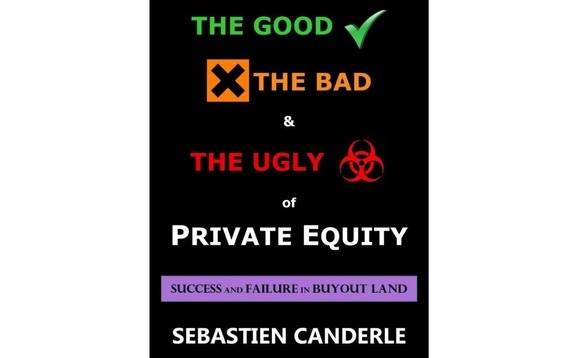
Q&A: Sebastien Canderle

Former Carlyle director Sebastien Canderle recently published his latest book, The Good, the Bad and the Ugly of Private Equity. He discusses the bookтs main points and his views on private equity with Oscar Geen
Oscar Geen: What was your purpose in publishing this book and who do you think will benefit most from reading it?
Sebastien Canderle: My primary goal is informational and educational. The case stories were put together as part of lectures I gave at various business schools. I figured that investment professionals would greatly benefit from reading these stories.
It is surprising that the same mistakes seem to be repeated by fund managers at regular intervals. So a second objective of the book is to help practitioners improve their transactional skills.
OG: Starting off with the good, what are the main factors that contribute towards a 'good' private equity deal?
SC: At the outset, it is all about robust due diligence. A 'good' private equity decision-making process requires a disciplined approach to investing and portfolio monitoring, engaging deliberate analytical thought rather than relying exclusively on intuition.
Other important factors that constitute best practice include moderate leverage, methodical portfolio diversification, and the implementation of a medium-term value-creation strategy, often using a buy-and-build approach – in contrast to quick flips and the short-term sweating of assets.
OG: The book explores how irrational behaviour and unconscious biases lead to bad investment decisions. In your opinion, what could be done to mitigate these influences?
SC: Behavioural science has arguably been the most influential discipline in economics over the past 20 years. The merit of the research carried out by academics like Daniel Kahneman and Richard Thaler is to show that investment decisions and, by extension, performance are driven more by emotional and mental biases than by reason and skill.
The case studies in the book, be they the eventful history of 3i Group or the recent collapses of Toys 'R' Us and BHS, teach us that investment decisions remain subject to biases inherent to human nature. For years, the hedge fund community has factored psychological blind spots into its decision-making methodology. Private equity must similarly embrace the core concepts promoted by behaviourists.
OG: The topic of ESG-friendly investing has gained a lot of traction in private equity in recent years. Do you think this is a positive step for the industry?
SC: Definitely. There is no intrinsic contradiction between maximising investment performance and stakeholders' ethical considerations. Where the two often come into conflict is when one tries to prioritise short-term gains to the detriment of long-term value. This is where ESG criteria can make a difference, by softening the effects of the industry's worst externalities.
ESG policies can take time to deliver results, but they might actually counteract the worst aspects of behavioural heuristics. For instance, while herding is seen as a negative bias that leads to bubbles, if impact investing evolved as a standard feature of private equity, the herd mentality adopted by most fund managers would ensure that ESG considerations became part of investment and management practices.
OG: In general, how much do you think the private equity industry has changed and learned from its mistakes since you stopped working as a buyout fund manager?
SC: For the last five years, I have been advising family offices and high-net-worth individuals, helping them make investments in LBOs and startups. It is fair to say that, from a regulatory standpoint, not much has changed since the financial crisis. It is not surprising: regulators and legislators have bigger fish to fry.
To some extent, the progress made before the financial crisis in terms of corporate responsibility has stalled. The Walker Guidelines initiated in 2007 are frequently being ignored. Weak governance is one of the reasons my clients have chosen to invest their money directly rather than via a fund manager, which is not to say that the industry was not remodeled.
Over the past decade, generalist funds have shrunk in size or morphed into sector specialists. Similarly, the larger PE groups have diversified across all asset classes, from real estate to credit, infrastructure and even venture capital in order to tone down their exposure to the cyclicality of buyouts. But these changes were operational and strategic by nature, not behavioural.
OG: As pricing levels and dealflow for PE-backed buyouts continue to break post-crisis records, do you think we are close to a downturn?
SC: A downturn is always hard to predict. It is easy to find arguments in favour of an imminent crisis, given the overvaluation of major asset classes, but much harder to determine its timing with precision.
Private equity has reached new peaks, at least in terms of fundraising. The great deleveraging of 2008-11 is already forgotten. Yet, the buyout sector remains minute when compared to the rest of the financial industry – its influence cannot be deemed systemic. PE could get dragged into a market correction, but it is unlikely to be itself the trigger of a crash even if it might greatly accentuate the downward pressure on the broader economy due to its extensive use of debt.
OG: Do you think PE is better equipped to cope with a downturn now than it was in the early 2000s? And which parts of the market do you think are likely to be most resilient?
SC: The last two years have seen a return to very high leverage – debt-to-equity ratios of 70:30 and above are not uncommon – and covenant-lite structures are once again the norm. The latter should provide some 'resilience' to the sector since it will prove almost impossible for lenders to force restructurings when technical defaults occur.
But what that implies is that a downturn will generate many LBO zombies, companies requiring years to extricate themselves from their debt shackles or to go bust, as was the case with Toys 'R' Us, which spent 12 years under PE ownership before filing for bankruptcy last year. The industry gave this sort of painful experience a positive spin by launching longer-duration vehicles of 15 years-plus, creating a new product category in the process: patient capital. These funds should enable firms to withstand a crisis, especially with a well-diversified portfolio.
Yet individual buyouts could still fall victim to overleverage. It is in part why I published this book. Behavioural and institutional shortcomings continue to prevail; we must learn from past mistakes to make the PE ecosystem more resilient.
Sebastien Canderle is the author of The Good, the Bad and the Ugly of Private Equity. He has also contributed to a number of financial publications and lectured on private equity and venture capital at Imperial College Business School.
Latest News
Stonehage Fleming raises USD 130m for largest fund to date, eyes 2024 programme
Sponsor acquired the public software group in July 2017 via the same-year vintage Partners Group Global Value 2017
Stonehage Fleming raises USD 130m for largest fund to date, eyes 2024 programme
Czech Republic-headquartered family office is targeting DACH and CEE region deals
Stonehage Fleming raises USD 130m for largest fund to date, eyes 2024 programme
Ex-Rocket Internet leader Bettina Curtze joins Swiss VC firm as partner and CFO
Stonehage Fleming raises USD 130m for largest fund to date, eyes 2024 programme
Estonia-registered VC could bolster LP base with fresh capital from funds-of-funds or pension funds









